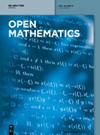有时间延迟的高度非线性中性随机微分方程的截断欧拉-丸山方法收敛率
IF 0.9
4区 数学
Q1 MATHEMATICS
引用次数: 0
摘要
本文可视为 Petrović 和 Milošević [The truncated Euler-Maruyama method for highly nonlinear neutral stochastic differential equations with time-dependent delay, Filomat 35 (2021), no. 7, 2457-2484] 的延续。 -型条件下,具有时延的中性随机微分方程的截断欧拉-Maruyama(EM)方法的收敛性。然而,该方法的收敛速率尚未得到研究,而这正是本文的主要目标。此外,对所考虑方程的截断系数也有一些限制,这些限制有时可能会迫使步长太小,从而限制截断电磁法的应用。因此,本文将考虑没有这些限制的收敛速率。此外,本文主要结果的一个充分条件(与中性项和延迟函数的 Lipschitz 常量有关)被弱化了。这样,引用文章中的一些结果就得到了推广。本文的主要结果是通过采用与所考虑方程的系数增量和中性项有关的两个条件以及其他条件证明的。主要理论结果通过一个例子来说明。本文章由计算机程序翻译,如有差异,请以英文原文为准。
Convergence rate of the truncated Euler-Maruyama method for highly nonlinear neutral stochastic differential equations with time-dependent delay
This article can be considered as a continuation of Petrović and Milošević [The truncated Euler-Maruyama method for highly nonlinear neutral stochastic differential equations with time-dependent delay , Filomat 35 (2021), no. 7, 2457–2484], where the authors established the L q {L}^{q} -convergence of the truncated Euler-Maruyama (EM) method for neutral stochastic differential equations with time-dependent delay under the Khasminskii-type condition. However, the convergence rate of the method has not been studied there, which is the main goal of this article. Also, there are some restrictions on the truncated coefficients of the considered equations, and these restrictions sometimes might force the step size to be so small that the application of the truncated EM method would be limited. Therefore, the convergence rate without these restrictions will be considered in this article. Moreover, one of the sufficient conditions for obtaining the main result of this article, which is related to Lipschitz constants for the neutral term and delay function, is weakened. In that way, some of the results of the cited article are generalized. The main result of this article is proved by employing two conditions related to the increments to the coefficients and the neutral term of the equations under consideration, among other conditions. The main theoretical result is illustrated by an example.
求助全文
通过发布文献求助,成功后即可免费获取论文全文。
去求助
来源期刊

Open Mathematics
MATHEMATICS-
CiteScore
2.40
自引率
5.90%
发文量
67
审稿时长
16 weeks
期刊介绍:
Open Mathematics - formerly Central European Journal of Mathematics
Open Mathematics is a fully peer-reviewed, open access, electronic journal that publishes significant, original and relevant works in all areas of mathematics. The journal provides the readers with free, instant, and permanent access to all content worldwide; and the authors with extensive promotion of published articles, long-time preservation, language-correction services, no space constraints and immediate publication.
Open Mathematics is listed in Thomson Reuters - Current Contents/Physical, Chemical and Earth Sciences. Our standard policy requires each paper to be reviewed by at least two Referees and the peer-review process is single-blind.
Aims and Scope
The journal aims at presenting high-impact and relevant research on topics across the full span of mathematics. Coverage includes:
 求助内容:
求助内容: 应助结果提醒方式:
应助结果提醒方式:


